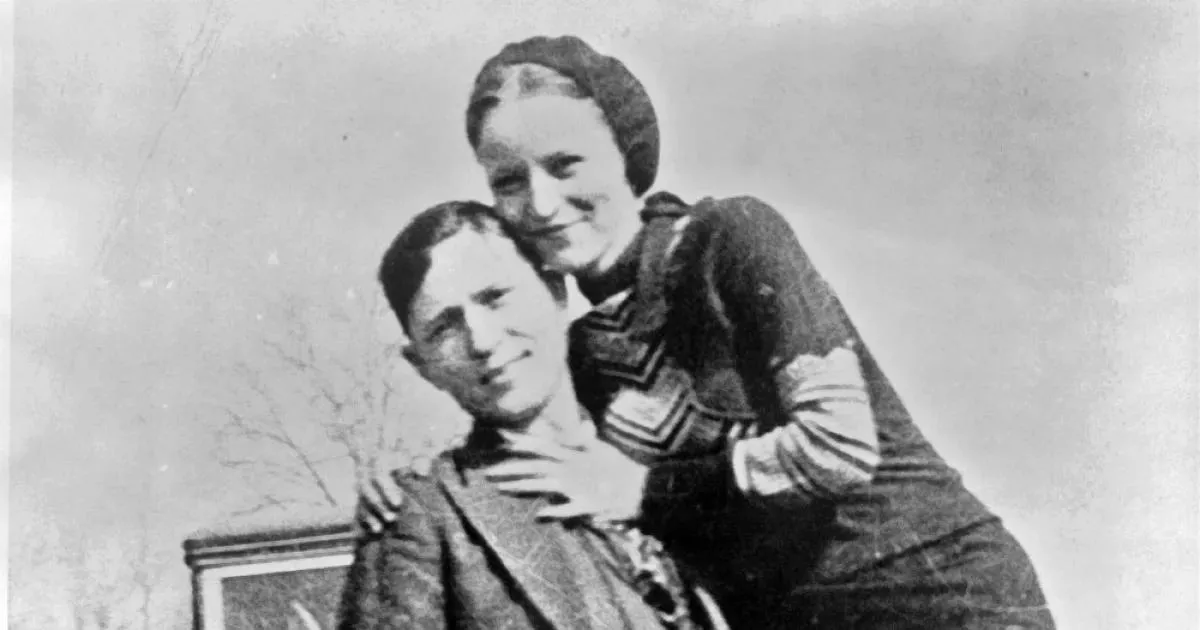Bonnie and Clyde were infamous American outlaws during the Great Depression. The duo, known for robbing banks and small businesses, gained notoriety for their crimes and became a media sensation. Their spree ended in Louisiana in 1934 when they were ambushed and killed by law enforcement. Their reign of terror included the murders of nine police officers and four civilians.
1908: Birth of Roy Thornton
Roy Thornton was born in 1908.
March 24, 1909: Clyde Barrow's Birth
Clyde Chestnut "Champion" Barrow was born on March 24, 1909.
1909: Clyde Barrow's Birth
Clyde Chestnut Barrow was born in 1909 in Ellis County, Texas to a family of poor farmers.
October 1, 1910: Bonnie Parker's Birth
Bonnie Elizabeth Parker was born on October 1, 1910.
1910: Bonnie Parker's Birth
Bonnie Elizabeth Parker, the second of three children, was born in Rowena, Texas in 1910.
1914: Death of Bonnie's Father
Bonnie's father, Charles Robert Parker, a bricklayer, passed away in 1914 when she was four years old.
September 25, 1926: Bonnie Parker's Marriage
Bonnie Parker, at 16 years old, married Roy Thornton on September 25, 1926.
1926: First Arrest of Clyde Barrow
Clyde Barrow had his first encounter with the law at the age of 17 in late 1926. He was apprehended after fleeing from police officers who confronted him about a rented vehicle that he hadn't returned as scheduled.
1927: Clyde Barrow's Attempts at Legitimate Work
Between 1927 and 1929, Clyde Barrow held several legal jobs.
January 1929: Separation of Bonnie and Roy
Bonnie Parker and Roy Thornton parted ways in January 1929, marking the end of their marriage.
1929: Clyde Barrow's Criminal Activities
From 1927 to 1929, Clyde Barrow engaged in criminal activities such as safecracking, store robbery, and car theft.
1929: Bonnie Parker Keeps a Diary
In 1929, at the age of 18, Bonnie Parker briefly maintained a diary.
January 5, 1930: Meeting of Bonnie and Clyde
It is believed that Bonnie Parker and Clyde Barrow first encountered each other on January 5, 1930, at the residence of Barrow's acquaintance, Clarence Clay, situated at 105 Herbert Street in West Dallas.
January 1930: Meeting of Bonnie and Clyde
Clyde Barrow met 19-year-old Bonnie Parker in January 1930, and they spent significant time together over the following weeks.
April 1930: Clyde Barrow's Imprisonment and First Murder
Clyde Barrow, at the age of 21, was incarcerated at Eastham Prison Farm in April 1930. While imprisoned, Barrow committed his first murder, killing a fellow inmate who had repeatedly sexually assaulted him.
1931: Beginning of the "Public Enemy Era"
The period between 1931 and 1934 is sometimes referred to as the "public enemy era," during which Bonnie and Clyde's exploits captivated the American press and public.
January 1932: Clyde Barrow's Self-Inflicted Injury
In late January 1932, Clyde Barrow, either by his own hand or with the help of another inmate, had two of his toes amputated to evade hard labor.
February 2, 1932: Clyde Barrow's Release from Prison
On February 2, 1932, Clyde Barrow was paroled from Eastham prison, emerging as a hardened criminal.
February 1932: Beginning of Bonnie and Clyde's Criminal Spree
February 1932 marked the start of Bonnie and Clyde's two-year crime spree.
February 1932: Clyde Barrow and Ralph Fults' Robbery Spree
Following his release from prison in February 1932, Clyde Barrow, along with Ralph Fults, embarked on a string of robberies targeting mostly convenience stores and gas stations.
1932: The Barrow Gang's Reign of Crime
Between 1932 and 1934, the Barrow gang, led by Bonnie and Clyde, were involved in robberies, kidnappings, and car thefts across states as far north as Minnesota, frequently releasing hostages far from home.
1932: W.D. Jones Joins Bonnie and Clyde
On Christmas Eve 1932, at the age of 16, W. D. Jones, a childhood friend of Barrow's family, joined Parker and Barrow.
1932: Ted Hinton Joins Dallas County Sheriff's Department
Ted Hinton, a postal worker and a regular customer at the Dallas diner where Bonnie Parker worked as a waitress, became a member of the Dallas County Sheriff's Department in 1932.
January 6, 1933: Murder of Tarrant County Deputy Malcolm Davis
Clyde Barrow killed Tarrant County Deputy Malcolm Davis on January 6, 1933, when he, Bonnie Parker, and W.D. Jones unwittingly walked into a police ambush intended for a different criminal.
March 1933: Roy Thornton Sentenced to Prison
Parker's husband, Roy Thornton, was given a five-year prison term for burglary in March 1933.
March 22, 1933: Clyde and Blanche Settle in Joplin Hideout with Bonnie, Clyde, and Jones
On March 22, 1933, Clyde's brother Buck, recently pardoned, and his wife Blanche moved in with Bonnie, Clyde, and Jones in Joplin, Missouri. Buck and Blanche tried to convince Clyde to surrender. The group drew attention with their loud, alcohol-fueled card games and Clyde accidentally firing his gun.
July 1933: Barrow Gang Raises Suspicions at Red Crown Tourist Court
In July 1933, the Barrow gang rented cabins at the Red Crown Tourist Court, raising suspicions by their number and Clyde's "gangster style" parking.
July 24, 1933: Buck Barrow Killed in Shootout with Police
On July 24, 1933, the Barrow gang's hideout at Dexfield Park was surrounded by police. In the ensuing shootout, Buck Barrow was fatally wounded and died five days later.
November 1933: Schmid's Failed Attempt to Arrest Barrow
In November 1933, lawman Schmid attempted to apprehend Barrow in Sowers, Texas, but his Thompson submachine gun malfunctioned, allowing Barrow to escape.
1933: Blanche Injured and Imprisoned
Blanche was blinded in her left eye during the Dexfield Park shootout in 1933. She was arrested, convicted, and sentenced to ten years for "assault with intent to kill."
1933: Darby and Stone Identify Bonnie and Clyde
In 1933, H.D. Darby and Sophia Stone, who had been kidnapped by the Barrow gang the previous year, were called upon to identify the bodies of Bonnie and Clyde.
1933: Imprisonment of Roy Thornton
Roy Thornton was sentenced to five years in prison for robbery in 1933.
January 1934: Escape from Eastham
Barrow's associates, Hamilton and Palmer, escaped from Eastham prison in January 1934.
January 16, 1934: Barrow Orchestrates Eastham Prison Break
On January 16, 1934, Clyde Barrow masterminded a daring prison break, freeing several inmates and garnering negative publicity for Texas.
April 1, 1934: Barrow Gang Kills Two Highway Patrolmen
On April 1, 1934, Barrow and an accomplice shot and killed two highway patrolmen in Grapevine, Texas, an event that sparked public outrage and increased pressure on authorities to apprehend the gang.
April 10, 1934: Barrow Writes to Henry Ford
On April 10, 1934, Barrow wrote a letter to Henry Ford expressing his admiration for Ford cars, particularly the V-8. The authenticity of the letter is debated.
May 1934: Hamer Tracks the Barrow Gang
By May 1934, Texas Ranger Frank Hamer was leading a posse tracking the Barrow gang. Hamer studied their movements and predicted their next destination would be Louisiana to visit Methvin's family.
May 1934: End of Bonnie and Clyde's Reign of Terror
May 1934 marked the end of Bonnie and Clyde's crime spree when they were ambushed and killed.
May 23, 1934: Deaths of Bonnie and Clyde
Bonnie and Clyde were ambushed by police and shot to death in Bienville Parish, Louisiana on May 23, 1934.
August 1934: Ruth Warren Claims Bonnie and Clyde's Death Car
In August 1934, Ruth Warren, the legal owner of the car in which Bonnie and Clyde were killed, successfully sued to reclaim the vehicle. Despite being riddled with bullet holes and stained with blood and tissue, the car was still functional.
1934: The Barrow Gang's Reign of Crime
Between 1932 and 1934, the Barrow gang, led by Bonnie and Clyde, were involved in robberies, kidnappings, and car thefts across states as far north as Minnesota, frequently releasing hostages far from home.
1934: Crackdown on Outlaws
Following Bonnie and Clyde's deaths in 1934, a nationwide crackdown on organized crime led to the demise of several notorious gangsters, including John Dillinger, Pretty Boy Floyd, and Baby Face Nelson.
1934: Methvin Convicted of Murder
Methvin was found guilty in Oklahoma of killing Constable Campbell in Commerce in 1934.
February 1935: Trial of Barrow and Parker's Associates
In February 1935, authorities in Dallas arrested and tried twenty friends and family members for helping Barrow and Parker. All were found guilty, with sentences varying from a brief detention to a two-year prison term.
May 10, 1935: Execution of Hamilton and Palmer
Hamilton and Palmer, Barrow's accomplices who had gotten away from Eastham in January 1934, were apprehended again. They were both found guilty of murder and put to death in the electric chair in Huntsville, Texas, on May 10, 1935.
October 3, 1937: Death of Roy Thornton
Roy Thornton was killed on October 3, 1937, while attempting to escape from the Huntsville State Prison.
1939: Blanche Paroled
After serving six years of her sentence, Blanche was paroled in 1939 for good behavior. She went back to Dallas, where she cared for her father and gave up her life of crime.
1940: Blanche's Marriage and New Life
Blanche married Eddie Frasure in 1940. She held jobs as a taxi dispatcher and a beautician. A year later, she had fulfilled the conditions of her parole.
1942: Death of Clyde's Mother
Clyde Barrow's mother, Cumie Talitha Walker, died in 1942.
1942: Methvin Paroled
Methvin was granted parole in 1942.
1944: Death of Bonnie's Mother
Bonnie's mother, Emma (Krause) Parker, who worked as a seamstress, died in 1944.
1945: Bonnie Parker's Remains Moved to Crown Hill Cemetery
In 1945, Bonnie Parker's remains were relocated to Crown Hill Cemetery in Dallas, despite her wish to be buried alongside Clyde Barrow.
1946: Death of Ivy Methvin
Ivy Methvin, Henry's father, died in 1946 after being hit by a car.
1948: Death of Henry Methvin
Henry Methvin died in 1948 after being struck by a train while intoxicated and sleeping on the tracks. Some believe he might have been murdered.
1948: Hamer and Stevenson Challenge Lyndon Johnson's Vote Count
In 1948, Hamer and Governor Coke Stevenson contested Lyndon Johnson's vote total in the U.S. Senate election. However, their challenge proved unsuccessful.
1955: Death of Frank Hamer
After several years of declining health, Frank Hamer died in 1955 at 71.
1957: Death of Clyde's Father
The father of Clyde Barrow, Henry Basil Barrow, passed away in 1957.
1958: The Bonnie Parker Story Released
The movie "The Bonnie Parker Story" was released in 1958.
May 23, 1964: Death of Bob Alcorn
On May 23, 1964, exactly 30 years after the Gibsland ambush, Bob Alcorn passed away.
1967: Blanche's Disapproval of Portrayal
Despite approving the initial script for the film, Blanche disagreed with Estelle Parsons' portrayal of her in the final version.
1967: Jones Gives Interview to Playboy
During the hype surrounding the 1967 movie, Jones was interviewed by Playboy magazine. In his interview, he stated that their life on the run was not as glamorous as portrayed.
1967: Bonnie and Clyde Movie Released
The film "Bonnie and Clyde" premiered in 1967.
1967: Release of "Bonnie and Clyde"
The movie "Bonnie and Clyde," directed by Arthur Penn and starring Warren Beatty and Faye Dunaway, was released in 1967, garnering both commercial and critical success.
1969: Death of Blanche's Husband
Blanche lived a peaceful life with Eddie until he passed away from cancer in 1969.
August 20, 1974: Death of W.D. Jones
On August 20, 1974, W.D. Jones died due to a misunderstanding involving the jealous boyfriend of a woman he was trying to help.
1979: Publication of Ambush: The Real Story of Bonnie and Clyde
In 1979, Hinton's account of Bonnie and Clyde's story, "Ambush: The Real Story of Bonnie and Clyde," was published after his death. The book presented his version of the Methvin family's involvement in the ambush.
December 24, 1988: Blanche Barrow's Death
On December 24, 1988, at the age of 77, Blanche passed away from cancer and was laid to rest in Dallas's Grove Hill Memorial Park.
1988: Bonnie and Clyde's Death Car Purchased by Casino
A casino near Las Vegas bought Bonnie and Clyde's death car for approximately $250,000 in 1988.
April 1, 2011: Honoring Edward Bryan Wheeler
On April 1, 2011, officials from the Texas Rangers, Texas Highway Patrol, and Texas Department of Public Safety honored patrolman Edward Bryan Wheeler, who was killed by the Barrow gang on April 1, 1934.
2018: Campaign to Reunite Bonnie and Clyde in Death
As of 2018, a campaign was underway to honor Bonnie and Clyde's wish to be buried together, reflecting the enduring interest in their story.
2019: Release of "The Highwaymen"
Netflix released "The Highwaymen" in 2019, a film that chronicled the manhunt for Bonnie and Clyde from the viewpoint of the lawmen involved.
2019: The Highwaymen Released
The movie "The Highwaymen" was released in 2019.
2023: Reward Offered for Bonnie and Clyde
In 2023, a historical event was recalled where a reward equivalent to $22,776 was placed on Bonnie and Clyde, signifying the growing pressure to bring the notorious outlaws to justice.
2023: Adjusting for Inflation
The purchase price of the death car in 1988 is equivalent to $644,063 in 2023.
Mentioned in this timeline

Christmas is an annual festival celebrated on December th commemorating...
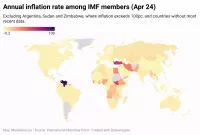
Inflation in economics signifies an increase in the average price...

Las Vegas Nevada's most populous city and the seat of...

A car also known as an automobile is a wheeled...

Dallas is a major city in Texas United States and...
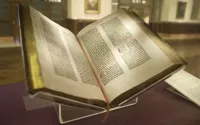
Books are a means of storing information as text or...
Trending

9 months ago Matt Kuchar plays The Players while grieving the loss of his father, Peter.
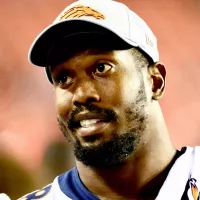
21 days ago Von Miller faces Broncos after Commanders choice; future Denver return uncertain.

5 months ago JD Vance to promote Trump's agenda bill in Pennsylvania next week.
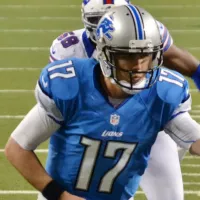
23 days ago Kellen Moore's Impact: Saints' QB Change and 2026 NFL Draft Predictions Emerge

5 months ago Myles Garrett sets Super Bowl goal, Stefanski faces pressure, DPOY odds revealed.

Ladd McConkey is a professional American football wide receiver currently playing for the Los Angeles Chargers He was drafted in...
Popular

Candace Owens is an American conservative political commentator and author...

Tucker Carlson is an American conservative political commentator known for...

XXXTentacion born Jahseh Dwayne Ricardo Onfroy was a controversial yet...

Ben Shapiro is a prominent American conservative political commentator media...

William Franklin Graham III commonly known as Franklin Graham is...

Bill Gates an American businessman and philanthropist revolutionized personal computing...
